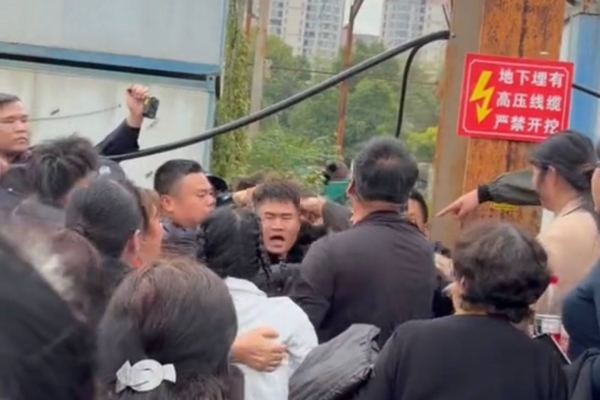On November 12th, in the Yuhua District of Changsha City, Hunan Province, residents of the Fenghua Community in the Jindi DuHui Complex opposed the authorities’ plan to build a 110kV substation near the school and kindergarten in the community. The incident led to clashes between the community residents and the construction team, resulting in injuries to some residents.
One of the residents, Fang Ming (pseudonym), recounted the events to a reporter.
A few days ago, the construction team of the substation posted a notice stating their intention to conduct on-site surveys. Fang Ming stated that they did not follow any procedures, did not go through the necessary approvals, nor did they seek input from the homeowners.
On November 12th, workers directly entered the site for the survey, which prompted over a hundred community residents to rush over to stop them. “We tried to communicate with them, but then about five or six police cars arrived with officers acting aggressively and warning us,” Fang Ming said. The authorities claimed the survey was unrelated to the substation construction, but the homeowners did not believe their explanation.
Fang Ming also revealed that during the confrontation, there were physical clashes between the community residents, the construction team, and the police officers, leading to an elderly woman being pushed down. The homeowners called the police for help, but even after nearly two hours, no officers arrived. It was only when the construction team contacted the police that they finally showed up. The elderly woman was reportedly taken to the hospital.
According to the reporter’s findings, the site planned for the substation is located in the Hongxing South Control Plot S11-G237 of the Yuhua District. On June 12th of this year, the Changsha Natural Resources and Planning Bureau adjusted the land use nature and indicators of this plot to promote the construction of public facilities.
The community residents disclosed that they were informed by relevant departments that the adjustment of the plot was for the construction of the 110kV substation. The S11-G237 plot used to be designated as green space, part of the city’s green belt. Per the “Changsha Urban Greenbelt Ecological Design Guidelines,” within 100 meters of the urban greenbelt, the addition of new buildings is not allowed. After the greenbelt is set up, the land use nature should not be altered. Therefore, the homeowners lodged a complaint against this adjustment, hoping the government would halt the project.
Fang Ming stated that the original plan for the substation was in other locations such as a residential community or Xian Gulfan Park, but due to opposition from nearby residents, it was relocated to this site. “They adjusted the plan when there was opposition before, but now when we oppose, they are forcefully pushing forward. This is unfair,” Fang Ming expressed.
Community residents have been actively advocating against the construction of the substation. They have had meetings with the local authorities, and residents have followed proper procedures for petitioning. However, following each meeting, the homeowners involved in rights protection activities were harassed at their homes by officials and police officers. “These officials go to some neighbors’ homes to intimidate and threaten them, warning them not to cause trouble and reminding us to follow the correct channels for rights protection,” Fang Ming added. Company leaders also warned employees not to lead rights protection efforts.
The fundamental reason the homeowners vehemently oppose the construction of the substation is its proximity to the community kindergarten, just 100 meters away, and the primary school, less than 200 meters away. It is situated very close to the kindergarten and school, with 1,700 households in between, and surrounded by other nearby communities.
The homeowners argue that building the substation in such a densely populated residential area will severely impact residents’ health. There is ample scientific evidence both domestically and internationally indicating that electromagnetic radiation above 0.2 microteslas could harm human health (the International Agency for Research on Cancer of the World Health Organization classifies extremely low-frequency magnetic fields as “possibly carcinogenic”).
It is known that electromagnetic waves pose numerous threats to human health. Prolonged exposure in such an environment can disrupt the body’s ecological balance, particularly affecting the nervous and cardiovascular systems. Symptoms may include fatigue, memory loss, insomnia, irritability, menstrual irregularities, chest discomfort, palpitations, decreased white blood cells and platelets, lowered immune function, among others.
The reporter attempted to contact the Yuhua District Street Office but was unable to reach them by phone.

